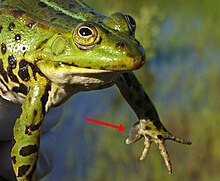Oestrus


Oestrus calluses , also rut or mating calluses , are rough, single to multilayered, horny , dark areas of the skin in many male frogs (also with individual tail amphibians ), which enable them to hold the mating clasps ( amplexus ) more firmly. This secondary sex characteristic is therefore sex dimorphism . Depending on the type , the insides of the first one to three fingers, the insides of the upper and lower arms ( toads ) or the chest ( mud diver ), and more rarely the abdomen or lower jaw, can have such calluses. These are often underlaid with a skin gland pad, but sometimes also pronounced as horny bumps or thorns. Since the callus formation is influenced by the gonadal hormones, the oestrus calluses are less noticeable outside the reproductive period and often fade.
A large number of male frogs show seasonal heat calluses, including water frogs and brown frogs , for example, usually only have one thumb callus on the innermost finger (this is noticeably thickened; see photo above), male common toads , on the other hand, have thinner blackish coatings on each of the three inner fingers Hand (see photo below). Of the few tailed amphibians with oestrus calluses on the fore and rear extremities, European mountain newts , the Spanish ribbed newt and American newts of the genera Notophthalmus and Taricha are to be mentioned.
swell
- Klaus Kabisch: Dictionary of Herpetology. Gustav Fischer Verlag, Jena 1990, ISBN 3-334-00307-8 , p. 76.
- Andreas Nöllert, Christel Nöllert: The amphibians of Europe . Franckh-Kosmos, Stuttgart 1992, ISBN 3-440-06340-2 , p. 33 ff.